|
Is that
Vern Estes in that foxhole
preparing to push the launch button? Probably not, but the materials and methods
used here in this 1948 issue of Popular Science magazine by amateur
rocketeers are a big part of the motivation Mr. Estes had for starting his
eponymously named model rocket company in 1958. To wit: "Rocket is driven by 35 pounds of micro grain
powder, mostly zinc dust and sulphur, which burns out in four seconds. It climbs
to 4,000 feet and reaches speed of more than 400 m.p.h." Handling the explosive
and sometimes unstable chemicals required for the rocket engines was extremely
dangerous, and resulted in many instances of loss of fingers and eyes, severe
burns, and even death. The safety record of Estes engines is borne out by more
than sixty years of continuous production. If they were not nearly perfectly
safe, lawyers would have put Estes out of business long ago. Even Olympic level
stupid has not produced an event capable that anything other than the user's
idiocy was responsible for an engine-related accident.
Rockets Carry the Mail
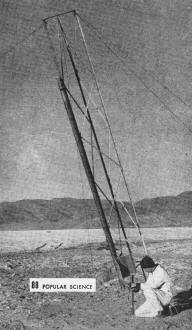
Launching tower, below, is 14 feet tall. The
rocket slides along an aluminum T-stock on three ball-bearing clips. Operator in
foreground is connecting ignition wires to fuse.
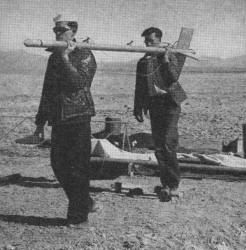
Mail-toting rocket is a stainless-steel tube
11 feet 3 inches long. Unloaded, it weighs only 60 pounds. Cost: $50. Letters are
carried inside four tail fins that stabilize it in flight.
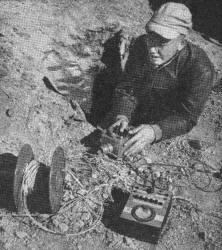
In foxhole a safe 250 feet from the launcher,
rocketeer below closes contact to fuse squid, now packed in rocket's tail behind
propelling fuel. Car battery supplies the firing charge.
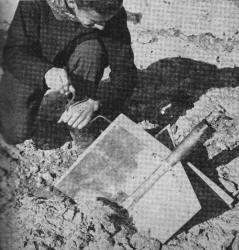
At its destination spent rocket is dug from
salty earth in which it buried itself on landing. Tail is then removed for easier
handling, and a brace is used to take covers off fins.
Water barriers and impassable terrain may be no more able to halt the mails than
the traditional snow, rain, heat, or gloom of night, if these experiments work out.
Rocket postmen can hurdle obstacles in a .few seconds, as shown in these pictures.
Here the fiery missiles are carrying letters a mile and a half across Searles Dry
Lake in southern California.
The demonstrators are amateur rocketeers of the Glendale, Calif., Reaction Research
Society, whose 90 members are mostly high-school and college students. Their work
carries forward experiments broken off in Austria, Germany, and England when rockets
were drafted for war.
The equipment seen in action here could speed the delivery of letters to off-shore
islands surrounded by heavy surf or to villages in mountainous territory where a
mile or two might be a day's walk. It could also be adapted for use on mail steamers
that must travel for hours along a coast before making port.
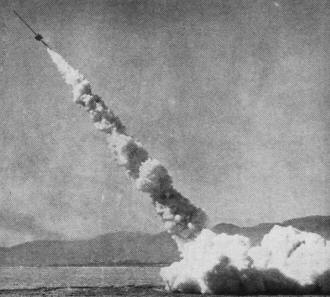
Rocket is driven by 35 pounds of micro grain
powder, mostly zinc dust and sulphur, which burns out in four seconds. It climbs
to 4,000 feet and reaches speed of more than 400 m.p.h.
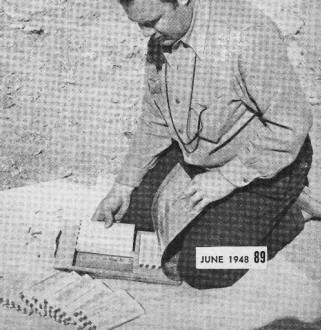
Opened fin shows compartments where letters
are carried. Each of the four sections of the rocket's tail has room for 300. Fins
are made of aluminum sheets on frame of 1/2-inch plywood.
Posted February 24, 2024
|